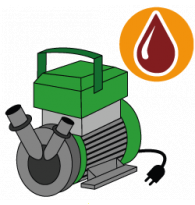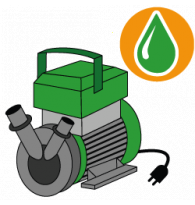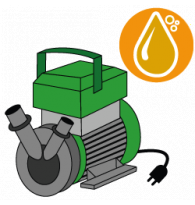- Transfer pumps for wine and other liquids: ideal for the wine industry, these pumps are designed to gently handle wine while preserving its organoleptic characteristics.
- Oil transfer pumps: specifically designed for oil, these pumps ensure that the product retains all its properties during transfer..
- Transfer pumps for beer and hot liquids: suitable for the brewing industry, these pumps can withstand high temperatures, ensuring safe and undisturbed transfer.
- Transfer pumps for diesel fuel: built to handle flammable liquids, these pumps are robust and safe, ideal for agricultural and industrial use, ensuring safe and efficient transfer of diesel fuel.
What they are and what they look like
The transfer pumps are devices used for transfer various types of liquids from one container to another safely and efficiently. They consist of several basic components that determine their operation and effectiveness. The main components of a transfer pump include:
- Pumping element: the heart of the pump responsible for the movement of the liquid. It can be made of bronze known for its resistance to corrosion or of an anti-oxidising alloy specially designed for use in environments requiring resistance to oxidising agents.
- Motor: provides the energy required to run the pump. It can be powered electrically via a power outlet or from a 12V car-type battery, offering flexibility according to operational needs.
- Fittings: connect the pump to the suction and discharge pipes. The diameter of the fittings usually between 20 and 30 mm determines how much liquid the pump can transfer.
- Non-return valve: prevents liquid backflow by ensuring that the fluid only flows in one direction.
- Pump body: contains and protects all internal components ensuring the stability and integrity of the system.
How do liquid transfer pumps work?
Il operation of food and non-food liquid transfer pumps is based on a liquid suction and thrust mechanism. When the pump is activated, the pumping element creates a pressure difference that sucks the liquid into the pump casing through the suction pipe. The motor supplies energy to the pumping element and then pushes the liquid towards the outlet through the delivery pipe.
- Suction: the liquid is sucked into the pump casing by the pressure difference created by the pumping element.
- Thrust: the pumping element powered by the motor pushes the liquid through the delivery pipe exceeding the maximum head, which can vary from 5 to 25 metres depending on the model.
- Flow control: the non-return valve ensures that the liquid only flows in the desired direction, preventing unwanted backflow.
Liquid pumps can be bi-directional allowing the pumping direction to be reversedwithout having to change the pipe connection. This increases the versatility of the pump, making it suitable for various applications.
Advantages of liquid transfer pumps
The transfer pumps offer numerous advantages making them an excellent choice for transferring various types of liquids. Compared to other transfer methods, these pumps provide efficiency, safety and versatility in multiple applications.
- Operational efficiency: transfer pumps make it possible to transfer large quantities of liquids in a short time, considerably reducing the time required for transferring compared to manual methods. This is particularly useful in industrial and agricultural environments where time is a critical factor.
- Security: the use of transfer pumps minimises the risk of spills and contamination, while protecting both the operator and the environment. Non-return valves and corrosion-resistant materials help maintain a safe working environment.
- Versatility: there are specific models for each type of liquid, such as wine oil beer and diesel. This ensures that the liquid is transferred under ideal conditions, preserving its properties and avoiding cross-contamination..
- Dosing accuracy: the ability to precisely control the flow of liquid allows for accurate dosing which is essential for applications requiring precision such as in beer and wine production.
- Reducing waste: thanks to their efficient design, transfer pumps minimise liquid losses during transfer, resulting in a more economical use of resources.
- Adaptability: bi-directional pumps can reverse the pumping direction, offering greater flexibility in transfer operations. This is particularly useful in situations where the flow direction needs to be changed frequently.
Comparing wine oil beer and diesel transfer pumps with other systems clearly shows their superiority in terms of efficiency and safety. For example, compared to manual transfer methods, pumps greatly reduce the risk of human error and improve the speed and accuracy of transfer. Compared to gravity transfer systems, pumps offer greater control over the liquid flow, allowing even viscous or sensitive liquids to be handled more easily..
Types of liquid transfer pumps
The liquid transfer pumps are available in different types each designed for specific liquid transfer needs. Let's look at the main types of transfer pumps available on the market and their distinguishing features.
- Transfer pumps for wine and other liquids
- Oil transfer pumps
- Transfer pumps for beer and hot liquids
- Transfer pumps for diesel fuel
Transfer pumps for wine and other liquids
The wine pumps are designed to gently transfer wine while preserving its organoleptic characteristics. These pumps are often used in wine cellars and wineries to move wine between containers during the production process..
- Materials: made of bronze or antioxidant alloy to resist corrosion and guarantee the purity of the wine.
- Motor:electrically powered for immediate start-up and continuous, stable operation.
- Fittings: with diameters ranging between 20 and 30 mm ideal for handling large quantities of wine without altering its properties.
These pumps ensure a gentle transfer of wine while minimising oxidation and the loss of aromas and flavours. Their specific design makes them indispensable for maintaining the high quality of the final product.
Oil transfer pumps
The oil pumps are designed to manage the viscosity and unique properties of the oil ensuring that it is transferred without alteration.
- Materials: bronze and antioxidant alloys to prevent foaming and keep the oil pure.
- Motor: available in electric and battery-powered versions offering flexibility according to the operating environment.
- Fittings: designed to handle the viscosity of the oil with diameters that facilitate a continuous and smooth flow.
These pumps are essential for the oil industry, ensuring efficient and safe transfer of oil while preserving all its nutritional and organoleptic properties.
Beer and hot liquid transfer pumps
The beer pumps are designed to withstand high temperatures, ensuring that the liquid is transferred safely without alteration.
- Materials:use special alloys that resist high temperatures and corrosion.
- Motor: electricity to ensure continuous and stable operation even at high temperatures.
- Fittings: designed to handle hot liquids, ensuring a steady and safe flow.
These pumps are particularly used in craft and industrial breweries, where it is essential to maintain the quality of the beer during the transfer process by avoiding contamination and loss of organoleptic properties..
Transfer pumps for diesel fuel
The diesel pumps are designed to handle the transfer of flammable liquids safely and efficiently. These pumps are essential for agricultural and industrial use, where it is essential to ensure that diesel fuel is handled without risk of spillage or fire.
- Materials: diesel pumps are made of chemical and mechanical resistant alloys that prevent corrosion and ensure a long service life. Materials such as stainless steel and specific alloys are commonly used to ensure robustness and safety.
- Motor: pumps can be powered electrically or by batteries, offering versatility depending on the operating environment. Electric motors are preferred for their ability to run continuously and stably.
- Safety devices:include non-return valves level sensors and automatic extinguishing systems to prevent accidental spills and minimise the risk of fire.
- Fittings: designed to ensure a safe and leak-free connection, with diameters that facilitate a constant and smooth flow of fuel oil. The fittings are often equipped with quick-closing systems to facilitate connection and disconnection.
- Head and flow rate: diesel pumps must have sufficient head to transfer the liquid over long distances or at considerable heights, and sufficient flow to handle large volumes of diesel in a short time.
These pumps are crucial in ensuring the safe and efficient transfer of diesel fuel, reducing downtime and improving productivity in agriculture and industry. The use of robust materials and advanced safety systems makes these reliable and durable pumps ideal for intensive operations.
Why is it not possible to use one pump to transfer all the different types of liquids?
Differences in the chemical and physical properties of various liquids make it essential to use specific pumps for each type of liquid.Here are the main reasons why one pump cannot be used for all liquids:
- Chemical reactivity: each liquid has a different chemical reactivity. Using a non-compatible pump can lead to unwanted reactions, damaging the pump and contaminating the liquid..
- Viscosity: liquids have different viscosities. A pump designed for low-viscosity liquids such as wine may not work properly with thicker liquids such as oil, causing clogging and inefficiency.
- Operating temperature: pumps for hot liquids must withstand high temperatures, whereas pumps for liquids at room temperature do not. Improper use can lead to mechanical failure and safety hazards.
- Organoleptic properties: liquids such as wine and beer require gentle transfers to maintain their organoleptic properties. An unsuitable pump can alter the taste and aroma, compromising the quality of the final product.
- Safety: Flammable liquids such as diesel fuel require specific safety measures to prevent fires and spills. An inadequate pump could pose a serious safety risk.
Technical characteristics of liquid pumps
The transfer pumps have several technical features which determine their effectiveness and adaptability to specific usage requirements. Let us look in detail at the main technical characteristics of these pumps.
Power supply
The liquid transfer pumps can be powered in different ways offering solutions for various operational needs.
- Electric: powered by a common power socket allows immediate start-up and continuous operation. Ideal for stationary applications.
- Car-type battery: powered by a 12V battery offers the flexibility needed for mobile and off-grid applications.
Materials
The materials used in the construction of transfer pumps are crucial to ensure their durability and resistance to corrosion.
- Bronze: used for the pumping element, known for its corrosion resistance and ability to maintain the properties of the liquid intact.
- Antioxidant alloy: a special alloy designed to resist oxidising agents and guarantee optimal performance over time.
Possibility to be two-way
One of the distinguishing features of some liquid transfer pumps is their ability to operate in two-way mode.
Two-way pumps are designed with a internal mechanism to reverse the flow of liquid. This is achieved through a system of valves or gears that when activated change the direction of movement of the pumping element. This allows the pump to suck liquid from one side and send it to the other, or to reverse this operation with a simple control.
- Reversing flow:the operator can change the direction of liquid flow without having to disassemble or reconfigure the pump, making transfer operations much quicker and easier.
- Valve system: the pump uses valves that open and close according to the desired flow direction, ensuring that the liquid flows in the direction set by the operator.
- Simple control: reversing the flow can often be done by means of a simple switch or electronic control, facilitating the operation even for less experienced operators.
Fitting diameter
The diameter of the transfer pump connections is related to the amount of liquid that the machine can move.
- Fittings 20 to 30 mm: the diameter of the fittings varies according to the capacity of the pump, influencing the flow and transfer speed of the liquid.
Maximum prevalence
The maximum head indicates the maximum height to which the pump can push the liquid.
- Prevalence from 5 to 25 metres: the pump's ability to overcome differences in height varies depending on the model, determining the effectiveness of the transfer in different operating situations.
Nominal power
The nominal power represents the commercial power attributed to the pump, which may differ from the actual power.
- Power from 0.5 to 3 HP: The nominal power indicates the theoretical performance of the pump, while the actual power measured at the motor shaft gives a more accurate indication of the operating capabilities.
Buying guide for transfer pumps
When choosing a transfer pump, it is essential to consider several factors to ensure that you are purchasing the most suitable product for your needs. Transfer pumps can be divided into two main categories of use: professional and industrial or domestic and hobbyist. Below is a detailed guide to help you choose.
Obviously first of all, it is necessary to identify the type of liquid oil wine beer diesel or other to be decanted.
- Professional or industrial liquid transfer pumps: these pumps are designed for intensive and frequent use. They are constructed with high quality materials such as bronze and anti-oxidising alloys to ensure durability and corrosion resistance. They offer increased head and power, making them suitable for transferring large volumes of liquids in industrial or agricultural environments.
- Transfer pumps for domestic or hobby use: these pumps are ideal for less intensive use. They are often lighter and easier to handle, with a focus on practicality and ease of use. They are perfect for small cellar gardens and other domestic applications.
Recommended types of users and pumps
- Winegrowers and wine producers: used to transfer wine between containers during fermentation and ageing. Pumps must be made of materials that do not react with the wine. We recommend choosing those with an electric motor for continuous operation and fittings suitable for large volumes of liquid.
- Oil mills and oil producers: used to transfer oil between settling tanks and storage tanks. The pumps must be constructed with anti-foaming antioxidant alloys and a motor with immediate start-up to handle the high viscosity of the oil.
- Craft and industrial breweries: used for the transfer of must and beer during the brewing and fermentation process. The necessary features for these transfer pumps are: resistance to high temperatures special alloys and the possibility of flow reversal for even mixing.
- Farmers: used for transferring diesel and other fuels for agricultural machinery. The characteristics required for these transfer pumps are robustness, safety against spills and the ability to handle flammable liquids.
The best brands of liquid transfer pumps
Buying transfer pumps from reputable brands ensures quality reliability and adequate service. Here is an overview of the main brands available on AgriEuro and their distinguishing features.
- Rover Liquid Transfer Pumps: known for manufacturing robust and reliable pumps, Rover Pumps offers solutions for both industrial and domestic applications. Their pumps are prized for their durability and corrosion resistance.
Why buy from AgriEuro?
Buying transfer pumps at AgriEuro offers numerous advantagesthat guarantee a satisfying and safe purchasing experience. Here are the main reasons why it is worth choosing AgriEuro for your transfer pump needs:
- Fast and free shipping: AgriEuro handles the shipment of products through its logistics centres, ensuring fast delivery at no extra cost. This allows you to receive your transfer pump quickly and start your transfer operations immediately..
- Spare parts always available: AgriEuro offers the possibility of easily ordering spare parts for all transfer pumps sold. This guarantees a long product life and the possibility of quick and easy repairs without prolonged business interruptions.
- Attentive and personalised after-sales service:AgriEuro's service team is available to support customers at every stage of the purchase and use of transfer pumps. From pre-purchase advice to troubleshooting technical problems, the service is professional and dedicated, ensuring that every customer gets the help they need.
Explore the wide range of transfer pumps available on AgriEuro and choose the model that best suits your needs.Benefit from free shipping, dedicated technical support and spare parts availability to ensure a safe and durable purchase.









